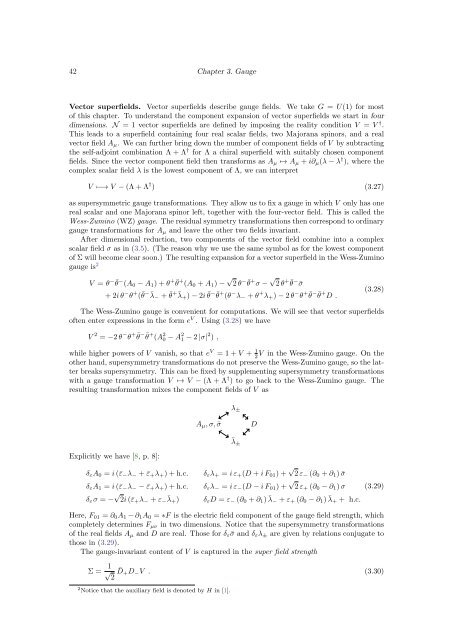The Bethe/Gauge Correspondence
The Bethe/Gauge Correspondence
The Bethe/Gauge Correspondence
You also want an ePaper? Increase the reach of your titles
YUMPU automatically turns print PDFs into web optimized ePapers that Google loves.
42 Chapter 3. <strong>Gauge</strong>Vector superfields. Vector superfields describe gauge fields. We take G = U(1) for mostof this chapter. To understand the component expansion of vector superfields we start in fourdimensions. N = 1 vector superfields are defined by imposing the reality condition V = V † .This leads to a superfield containing four real scalar fields, two Majorana spinors, and a realvector field A µ . We can further bring down the number of component fields of V by subtractingthe self-adjoint combination Λ + Λ † for Λ a chiral superfield with suitably chosen componentfields. Since the vector component field then transforms as A µ ↦→ A µ + i∂ µ (λ − λ † ), where thecomplex scalar field λ is the lowest component of Λ, we can interpretV ↦−→ V − (Λ + Λ † ) (3.27)as supersymmetric gauge transformations. <strong>The</strong>y allow us to fix a gauge in which V only has onereal scalar and one Majorana spinor left, together with the four-vector field. This is called theWess-Zumino (WZ) gauge. <strong>The</strong> residual symmetry transformations then correspond to ordinarygauge transformations for A µ and leave the other two fields invariant.After dimensional reduction, two components of the vector field combine into a complexscalar field σ as in (3.5). (<strong>The</strong> reason why we use the same symbol as for the lowest componentof Σ will become clear soon.) <strong>The</strong> resulting expansion for a vector superfield in the Wess-Zuminogauge is 2V = θ − ¯θ− (A 0 − A 1 ) + θ + ¯θ+ (A 0 + A 1 ) − √ 2 θ − ¯θ+ σ − √ 2 θ + ¯θ−¯σ+ 2i θ − θ + (¯θ −¯λ− + ¯θ +¯λ+ ) − 2i ¯θ − ¯θ+ (θ − λ − + θ + λ + ) − 2 θ − θ + ¯θ− ¯θ+ D .(3.28)<strong>The</strong> Wess-Zumino gauge is convenient for computations. We will see that vector superfieldsoften enter expressions in the form e V . Using (3.28) we haveV 2 = −2 θ − θ + ¯θ− ¯θ+ (A 2 0 − A 2 1 − 2 |σ| 2 ) ,while higher powers of V vanish, so that e V = 1 + V + 1 2V in the Wess-Zumino gauge. On theother hand, supersymmetry transformations do not preserve the Wess-Zumino gauge, so the latterbreaks supersymmetry. This can be fixed by supplementing supersymmetry transformationswith a gauge transformation V ↦→ V − (Λ + Λ † ) to go back to the Wess-Zumino gauge. <strong>The</strong>resulting transformation mixes the component fields of V asλ ±A µ , σ, ¯σD¯λ ±Explicitly we have [8, p. 8]:δ ε A 0 = i (¯ε − λ − + ¯ε + λ + ) + h.c.δ ε A 1 = i (¯ε − λ − − ¯ε + λ + ) + h.c.δ ε σ = − √ 2i (¯ε + λ − + ε −¯λ+ )δ ε λ + = i ε + (D + i F 01 ) + √ 2 ε − (∂ 0 + ∂ 1 ) ¯σδ ε λ − = i ε − (D − i F 01 ) + √ 2 ε + (∂ 0 − ∂ 1 ) σδ ε D = ε − (∂ 0 + ∂ 1 ) ¯λ − + ε + (∂ 0 − ∂ 1 ) ¯λ + + h.c.(3.29)Here, F 01 = ∂ 0 A 1 − ∂ 1 A 0 = ∗F is the electric field component of the gauge field strength, whichcompletely determines F µν in two dimensions. Notice that the supersymmetry transformationsof the real fields A µ and D are real. Those for δ ε¯σ and δ ε λ ± are given by relations conjugate tothose in (3.29).<strong>The</strong> gauge-invariant content of V is captured in the super field strengthΣ = 1 √2¯D+ D − V . (3.30)2 Notice that the auxiliary field is denoted by H in [1].
















